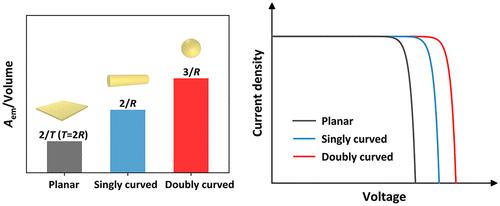当前位置:
X-MOL 学术
›
ACS Photonics
›
论文详情
Our official English website, www.x-mol.net, welcomes your feedback! (Note: you will need to create a separate account there.)
Curving Solar Cells Beyond the Planar Efficiency Limit
ACS Photonics ( IF 6.5 ) Pub Date : 2024-05-28 , DOI: 10.1021/acsphotonics.4c00140 Haofeng Zheng 1 , Yanlong Wang 1 , Dechun Zou 2 , Shaocong Hou 1, 3
ACS Photonics ( IF 6.5 ) Pub Date : 2024-05-28 , DOI: 10.1021/acsphotonics.4c00140 Haofeng Zheng 1 , Yanlong Wang 1 , Dechun Zou 2 , Shaocong Hou 1, 3
Affiliation

|
Curving surface is the feature of flexible electronics; however, fundamental theoretical research, such as the efficiency limit of curved optoelectronics significantly lags behind experimental works as well as the planar counterpart. Here, we propose a theoretical framework suitable for curved photovoltaics by developing a geometrically modified thermodynamic model of solar cell radiation. By considering singly and doubly curved structures, we reveal that the efficiency limit of solar cells, such as perovskite devices, increases with the mean curvature when nonradiative recombination processes are considered. The reduction in nonradiative voltage losses of the spherical and fiber-shaped solar cells originates from weaker photon recycling, which is primarily decided by the absorptance as well as the ratio of emission area to light-absorbing volume, revealing a negative correlation. Our work provides an in-depth understanding and theoretical guidance on flexible electronics.
中文翻译:

弯曲太阳能电池超越平面效率极限
曲面是柔性电子的特征;然而,基础理论研究,例如弯曲光电子学的效率极限,明显落后于实验工作以及平面光电子学。在这里,我们通过开发太阳能电池辐射的几何修改热力学模型,提出了适合弯曲光伏发电的理论框架。通过考虑单曲率和双曲率结构,我们揭示了当考虑非辐射复合过程时,太阳能电池(例如钙钛矿器件)的效率极限随着平均曲率的增加而增加。球形和纤维状太阳能电池非辐射电压损失的减少源于较弱的光子回收,这主要取决于吸收率以及发射面积与光吸收体积的比率,呈现负相关。我们的工作提供了对柔性电子产品的深入理解和理论指导。
更新日期:2024-05-29
中文翻译:

弯曲太阳能电池超越平面效率极限
曲面是柔性电子的特征;然而,基础理论研究,例如弯曲光电子学的效率极限,明显落后于实验工作以及平面光电子学。在这里,我们通过开发太阳能电池辐射的几何修改热力学模型,提出了适合弯曲光伏发电的理论框架。通过考虑单曲率和双曲率结构,我们揭示了当考虑非辐射复合过程时,太阳能电池(例如钙钛矿器件)的效率极限随着平均曲率的增加而增加。球形和纤维状太阳能电池非辐射电压损失的减少源于较弱的光子回收,这主要取决于吸收率以及发射面积与光吸收体积的比率,呈现负相关。我们的工作提供了对柔性电子产品的深入理解和理论指导。






































 京公网安备 11010802027423号
京公网安备 11010802027423号